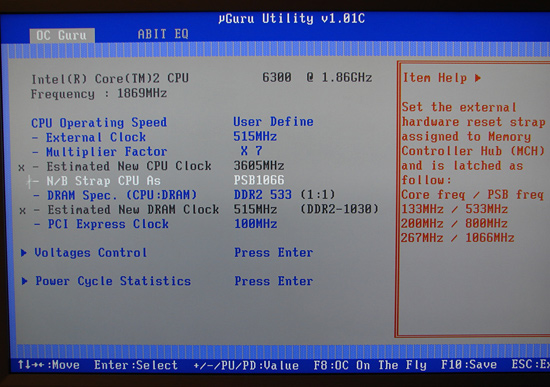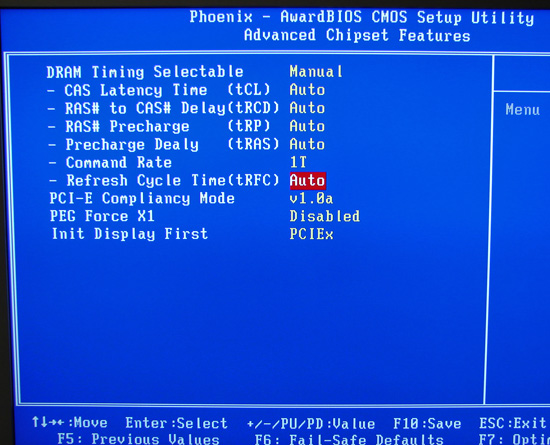Feature Set
abit has equipped this motherboard with a bevy of top end features and it is currently selling in the $219 range. The board features the Realtek ALC888 HD audio codec, Realtek RTL8810SC Gigabit Ethernet controller, dual e-SATA ports via the JMicron JMB363 chipset, and IEEE 1394 Firewire support. The accessory kit contains the basic SATA and IDE cables, external USB/Firewire bracket, and extensive documentation on the motherboard and µGuru functionality. However, abit did not include e-SATA cables and considering the cost of the kit we believe this in an omission.


The BIOS options for the AB9 QuadGT are fairly extensive for a motherboard in this sector, and of course the board features abit's excellent µGuru technology. The voltage options and availability of choices within each option will please the majority of enthusiasts. Besides memory voltage options up to 3.00V, the board also features the ability to change the command rate to 1T. In our initial testing we could not get 1T operation stable at DDR2-800 but were successful at DDR2-667 with a wide variety of Micron D9 based modules. However, we had trouble with several DDR2-667 modules based on Promos and Elpida memory ICs. The performance at DDR2-667 1T was equal to or up to 4% slower in several benchmarks when compared to DDR2-800 2T at the same memory latency timings. We believe abit still has significant tuning to complete to get 1T operating at DDR2-800 in a stable manner.
| abit AB9 QuadGT | |
| Market Segment: | Enthusiast Performance - $219.99 |
| CPU Interface: | Socket T (Socket 775) |
| CPU Support: | LGA775-based Pentium 4, Celeron D, Pentium D, Pentium EE, Core 2 Duo, Core 2 Extreme |
| Chipset: | Intel P965 + ICH8R |
| Bus Speeds: | 133 to 600 in 1MHz increments |
| Northbridge Strap: | CPU, 1066, 800, 533 |
| Memory Speeds: | SPD, 533, 667, 800 |
| PCIe Speeds: | 100 to 200 in 1MHz increments |
| PCI: | Fixed |
| Core Voltage: | Default, Base to 1.9250V in +.0100V increments |
| CPU Clock Multiplier: | Auto, 6x-11x in 1X increments if CPU is unlocked, Core 2 Duo downward unlocked |
| DRAM Voltage: | 1.800V to 3.000V in +.025V increments |
| DRAM- Ref Voltage: | +2%, 0%, -2%, -4% |
| DRAM Timing Control: | SPD, Manual, Auto or Manual for 6 DRAM Timing Options including Command Rate |
| MCH Voltage: | 1.25V to 1.70V in +.05V increments |
| CPU VTT Voltage: | 1.20V, 1.30V, 1.40V, 1.50V |
| ICH Voltage: | 1.05V, 1.10V, 1.15V, 1.20V |
| ICH IO Voltage: | 1.50V to 1.70V in +.05V increments |
| Memory Slots: | Four 240-pin DDR2 DIMM Slots Dual-Channel Configuration Regular Unbuffered Memory to 8GB Total |
| Expansion Slots: | 1 - PCIe x16 1 - PCIe x4 (x16 Physical) 1 - PCIe x1 2 - PCI Slot 2.3 |
| Onboard SATA/RAID: | 6 SATA 3Gbps Ports - RAID 0, 1, 5, 10 - Intel ICH8R 2 e-SATA 3Gbps Port - RAID 0, 1, JBOD - JMicron JMB363 |
| Onboard IDE: | 1 ATA133/100/66 Port (2 drives) - JMicron JMB363 |
| Onboard USB 2.0/IEEE-1394: | 10 USB 2.0 Ports - 4 I/O Panel - 6 via Headers IEEE 1394 - TI TSB43AB22A |
| Onboard LAN: | Realtek RTL8810SC - PCI Express Gigabit Controller |
| Onboard Audio: | Realtek ALC888 8-Channel HD Audio Codec |
| Power Connectors: | ATX 24-pin, 8-pin EATX 12V, 4-pin Molex |
| I/O Panel: | 1 x PS/2 Keyboard 1 x PS/2 Mouse 1 x CMOS Clear Switch 2 x S/PDIF Optical - In and Out 1 x IEEE 1394 Port 2 x e-SATA Port 1 x Audio Panel 1 x RJ45 4 x USB 2.0/1.1 |
| BIOS Revision: | Award 12/11/06 6A79LA1EC-10 |
abit has equipped this motherboard with a bevy of top end features and it is currently selling in the $219 range. The board features the Realtek ALC888 HD audio codec, Realtek RTL8810SC Gigabit Ethernet controller, dual e-SATA ports via the JMicron JMB363 chipset, and IEEE 1394 Firewire support. The accessory kit contains the basic SATA and IDE cables, external USB/Firewire bracket, and extensive documentation on the motherboard and µGuru functionality. However, abit did not include e-SATA cables and considering the cost of the kit we believe this in an omission.


The BIOS options for the AB9 QuadGT are fairly extensive for a motherboard in this sector, and of course the board features abit's excellent µGuru technology. The voltage options and availability of choices within each option will please the majority of enthusiasts. Besides memory voltage options up to 3.00V, the board also features the ability to change the command rate to 1T. In our initial testing we could not get 1T operation stable at DDR2-800 but were successful at DDR2-667 with a wide variety of Micron D9 based modules. However, we had trouble with several DDR2-667 modules based on Promos and Elpida memory ICs. The performance at DDR2-667 1T was equal to or up to 4% slower in several benchmarks when compared to DDR2-800 2T at the same memory latency timings. We believe abit still has significant tuning to complete to get 1T operating at DDR2-800 in a stable manner.










41 Comments
View All Comments
8KCABrett - Wednesday, February 7, 2007 - link
1. "loading the JMicron RAID driver instead the standard XP IDE driver" is a one time thing that can be done at installation and not worried about after that right?
2Does this lead to any other issues. . . is it still possible to use and IDE optical once this is done?
takumsawsherman - Wednesday, January 24, 2007 - link
Gigabyte may have had BIOS issues with the early releases, but their memory guide also gives a pretty good idea of what will work with the board. I have put in 2 P965 DQ6's recently). Both times I got the recommended Kingston kits, and everything works fine and is blazing fast. For the same price as this Abit is selling, it has 2 more SATA ports, 2 internal firewire headers (though I honestly don't know how many the abit has, both the abit and the gigabyte have a rear port built in), the DQ6 seems to have a better cooling system, a better floppy port location, better PCI-Express auxiliary power location, and it comes with 2 eSATA brackets, each with two ports, and 4 eSATA cables.Speaking of Kingston kits, one of the above posters was correct in asserting that many manufacturers ship an immature bios with their boards, and this has proved true for many P965 boards (1.8V only, etc.). A P965 is definitely not a platform on which I would want to muck around with enthusiast memory.
BTW, you should review the i-Star S-8 Storm Series enclosure. Best case I have used in a while, though they always seem to be trying to play some cruel prank by shorting you some screws. Luckily, building all of those Supermicro 750 and 760 based workstations years ago has left me with quite the surplus.
yyrkoon - Friday, January 26, 2007 - link
Its pretty much in-excusable, releasing a motherboard, using an enthusiast chipset, that doesn't support the best enthusiast memory chips. At least, from the enthusiasts perspective, thats all we were saying.RippleStrip - Tuesday, January 23, 2007 - link
Ok, so I've been out of it for a while. I remember reading on reviews for early 975s and 965s that it was possible to change the cpu multiplier (although sometimes only one way). Did Intel bop this on the head, or do some motherboards still do this? What about the nvidia boards?-Steven
SignalPST - Tuesday, January 23, 2007 - link
This has nothing to do with the article, but nevertheless, I'm dying to ask.Will AnandTech do a roundup of non-refrence nForce 680i motherboards once they are all out? So far, the guys that are or will be making them are ASUS, ABIT, GIGABYTE and DFI.
Gary Key - Tuesday, January 23, 2007 - link
Yes, finally received the new ASUS boards yesterday and the Gigabyte/abit boards are due this week.SignalPST - Tuesday, January 23, 2007 - link
Great! I'll be looking forward to the review, and I'm sure alot of people will be too.I get a sense that everyone is still tight-liped about the DFI nForce 680i motherboard :)
yyrkoon - Monday, January 22, 2007 - link
Heh, Gary, was that you on the ABIT forums that smoked the set of Corsair 6400 memory ? (because of the uGuru issue)Gary Key - Tuesday, January 23, 2007 - link
That was me. :)Heidfirst - Monday, January 22, 2007 - link
there's a new beta BIOS available for it already (the board hasn't even made it to retail in the UK yet).http://forum.abit-usa.com/showthread.php?t=119222">http://forum.abit-usa.com/showthread.php?t=119222
Tbh with market pressure & shipping schedules I think that many mobo mfrs are shipping boards with an initial slightly buggy BIOS hoping to have a better 1 available for download by the time that the boards hit retail.
e.g. look at Gigabyte's BIOS development for the P965 series or the fact that the Asus P5N-E SLI is still on the release BIOS & that could use more work too.
Is that ideal?
Of course not but it's commercial pressure driving it...